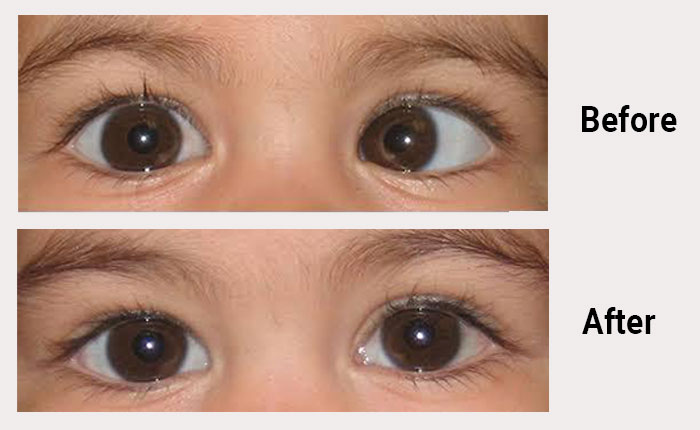

Squint Correction
Squint or strabismus is a misalignment of the two eyes where the eyes do not look in the same direction. That is, one eye may not focus on an object someone is looking at. When the patient is looking straight ahead, the other eye may turn either inwards, outwards, upwards or downwards.
This misalignment may be constant, or it may appear sometimes. Squint is commonly seen in children but may be present in adults also. Most squints in young children may be associated with weak eyesight. Squints that develop in adults are usually due to secondary causes like trauma, lesions in the brain, staring computer screen for long hours, etc. and their management is different from those in children. Typically, children with squint learn to suppress the image from the deviating eye, while adults report a double vision or diplopia.
Signs and symptoms in children
- The sign of a squint is fairly obvious from an early age. One of the eyes does not look straight ahead. A minor squint may be less noticeable.
- Infants and newborns may go cross-eyed, especially if they are tired. This does not mean that they have a squint. Parents can check with their doctor.
- If a child has one eye closed, or turns their head when looking at you, this could be a sign of double vision, and a possible squint. It is a good idea to see a doctor.
- Strabismus is normally either present at birth or it develops in the first 6 months after birth.
Causes
Strabismus can be:
- congenital, meaning a person is born with it
- hereditary, or running in families, suggesting a genetic link
- the result of an illness or long-sightedness
- due to a lesion on a cranial nerve
Diagnosis and treatment
- Children and babies should have routine eye checks as they develop. Starting eye tests at 9 months, or earlier if the child has a constant eye turn.
- If there are signs of strabismus, the physician or optician will refer the child to an ophthalmologist.
- The ophthalmologist will probably use eye drops that dilate the pupils before the test is done.
- The Hirschberg test, or Hirschberg corneal reflex test, is used to assess whether the patient has strabismus.
- The ophthalmologist shines a light in the eye and observes where the light reflects from the corneas.
Treatment options include:
- Glasses: If hypermetropia, or long-sightedness, is causing the squint, glasses can usually correct it.
- Eye patch: Worn over the good eye, a patch can get the other eye, the one with the squint, to work better.
- Botulinum toxin injection, or botox: this is injected into a muscle on the surface of the eye. The doctor may recommend this treatment if no underlying cause can be identified, and if signs and symptoms appear suddenly. The botox temporarily weakens the injected muscle, and this can help the eyes to align properly.
- Eye drops and eye exercises may help.



.png)

